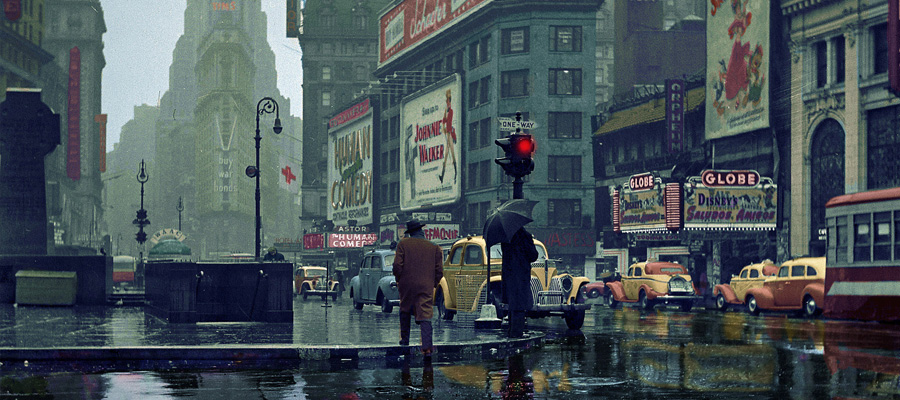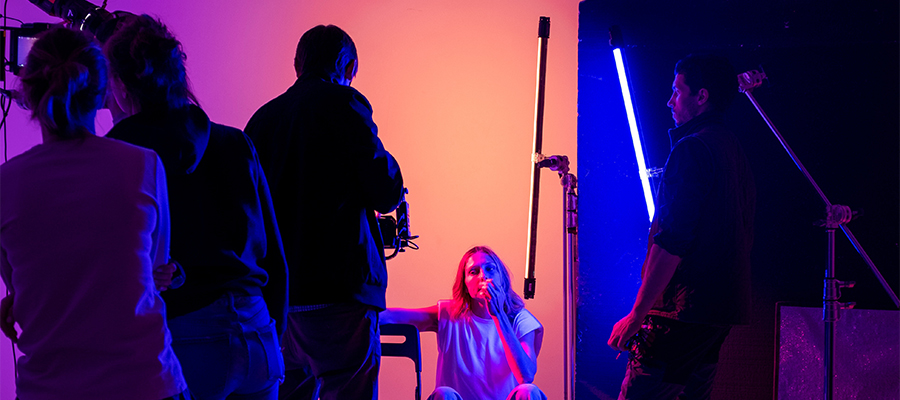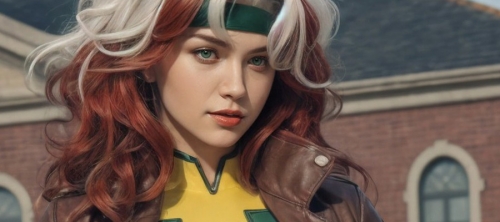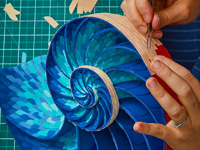Christ the Redeemer, Rio Brazil: art-history angles, the viral “Moon in His Hands” shot, smart photo tactics, and why a 600mm lens beats a drone, plus tips galore.
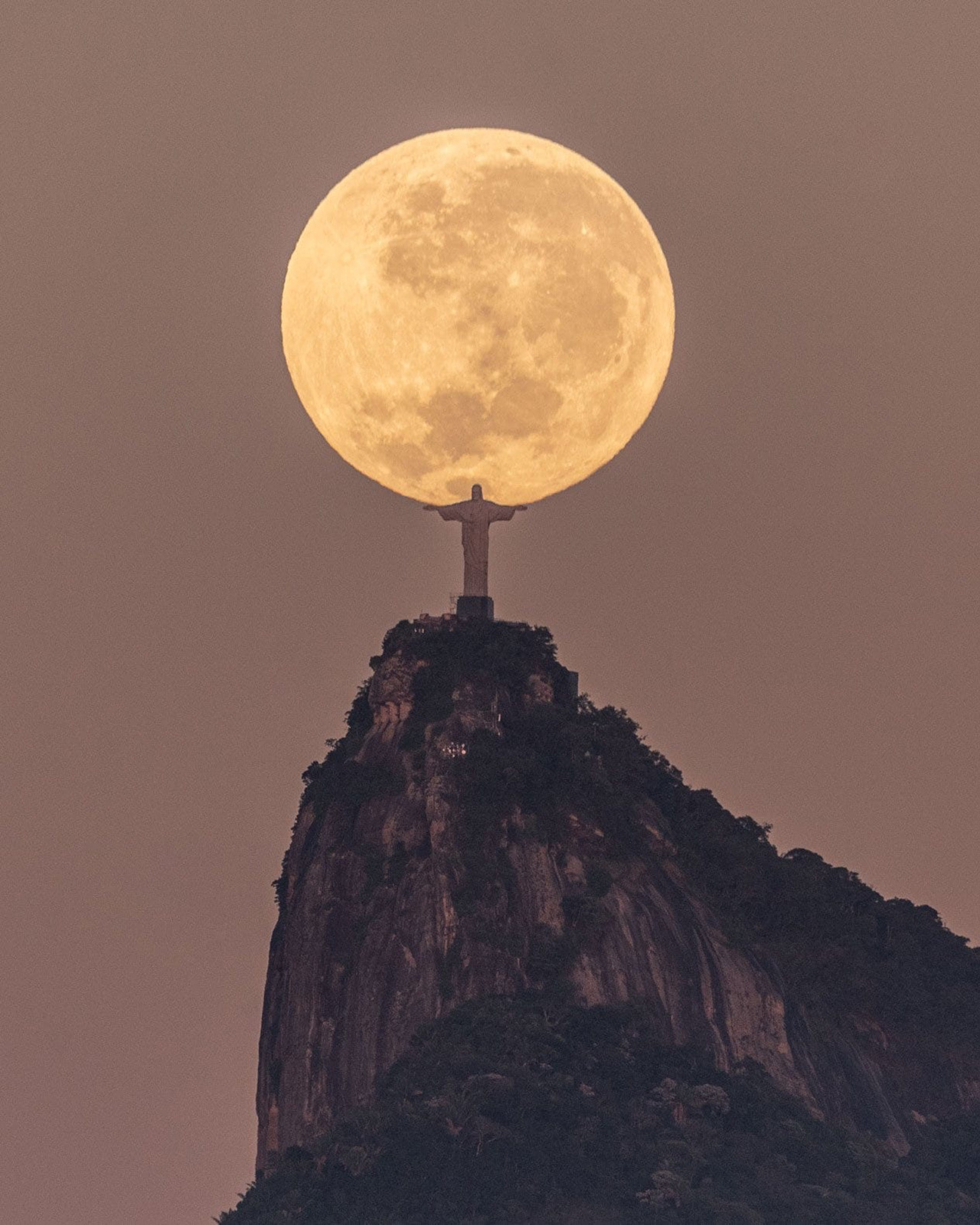
On a wind-tempered evening on Icaraí Beach in Niterói, across the bay from Rio, Brazilian photographer Leonardo Sens watched the Moon drift toward a familiar silhouette. He was ~11 km (~7 miles) away, by design. Distance, not proximity, was the key to making Christ the Redeemer look close enough to cradle the Moon without Photoshop. After three years of planning, haze-wrecked rehearsals, and a new telephoto lens, the moment arrived; the Moon slipped into those outstretched hands for a few quiet seconds, and the city collectively said: ah.
“I knew the exact moment, and still missed it the first time, the Moon goes down quite fast,” Sens told PetaPixel. The window for perfection is thinner than a sigh.
A Long Setup for a Short Miracle
The shot wasn’t luck; it was choreography. Sens studied lunar paths, checked weather against phases, and used mobile ephemeris apps to solve the basic riddle: from where, and exactly when, does the Moon intersect those hands? He kept returning, sometimes greeted by cloud and haze, until the sky finally cooperated. Viral numbers later (hundreds of thousands of people double-tapping agreement), the image read as both devotion and design.
Tip for art lovers: Treat this as site-specific performance with a celestial co-star. The statue is the stage; the Moon is the dancer who refuses to repeat choreography on cue.
Where the Picture Was Made, and Why That Distance Works
Icaraí Beach gives you a long baseline to Corcovado. At ~11 km, a 600mm lens narrows the field of view so the Moon and statue share one plane, what photographers casually call “compression,” but what is really just deliberate distance turned into intimacy. The effect is poetic, not tricksy: the hands look tender, the Moon looks tame. (Mirante Dona Marta is a superb backup viewpoint for alternate compositions.)
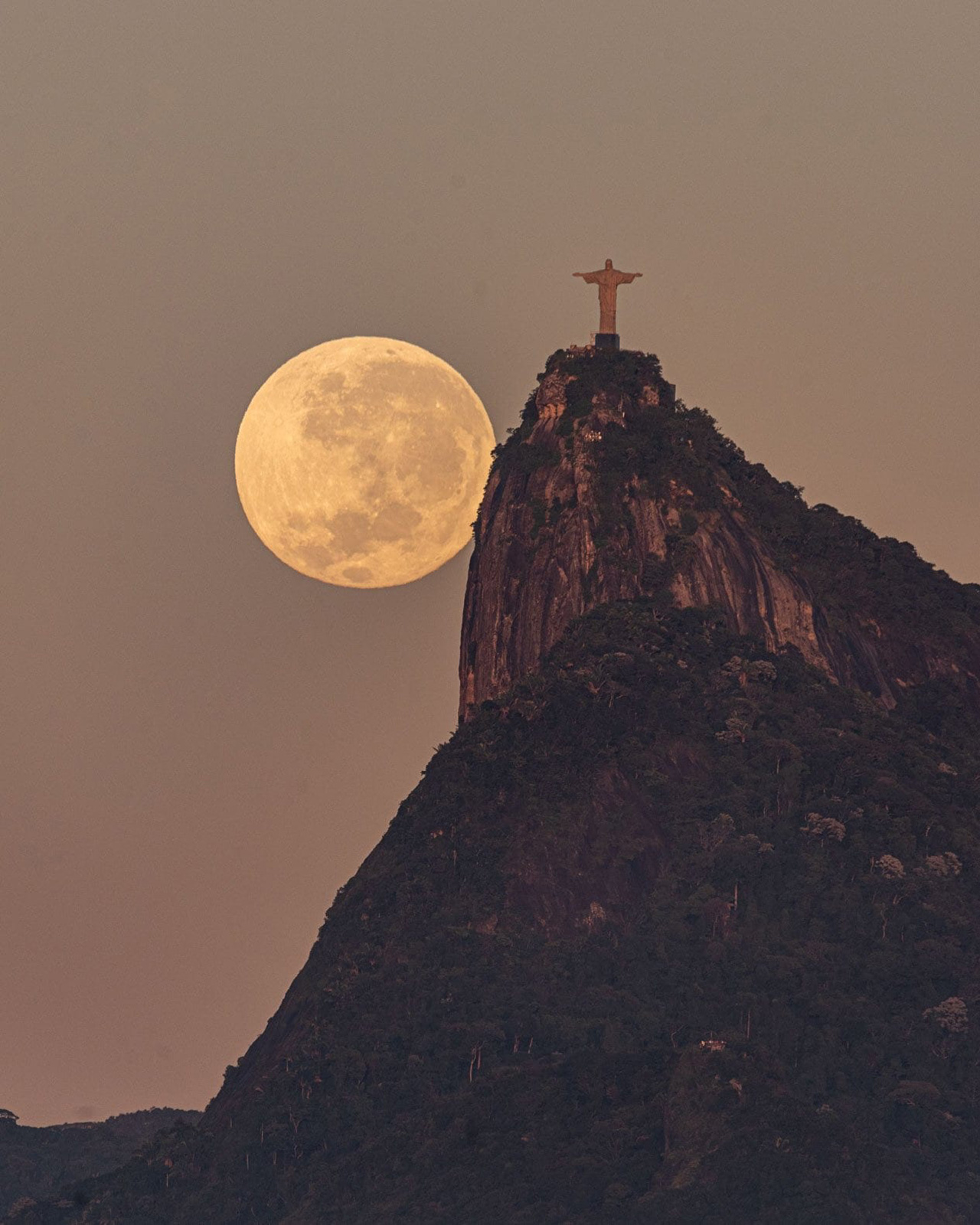
Pocket physics: The Moon slides ~0.5° every ~2 minutes. Miss by a few steps, miss the story. That’s why Sens arrived early and shuffled sideways when the seconds got loud.
The Tools Behind the Tenderness
Sens’s kit list is short and purposeful: mobile apps for azimuth/altitude predictions, a sturdy tripod, and in 2021 he bought a 600mm specifically so the Moon and Sun would read larger. Less gadget worship, more instrument choice, like selecting the right reed for a clarinet solo.
Quick trick: Expose for the Moon (protect highlights), bracket for the city glow, then decide whether you want one honesty-exposure or a subtle blend. Poets edit; so do photographers.
“Just Use a Drone”? Here’s Why the Ground Wins
Christ the Redeemer sits in Tijuca National Park, near busy air corridors with tourist helicopters, and within a tangle of authorities where the Archdiocese reportedly holds a veto on flights. Add Brazil’s ANAC rules, registration above 250 g, strict setbacks from people, and altitude constraints, and your airborne plan turns into administrative opera. The elegant answer is the one Sens chose: stand on the beach and let geometry fly.
Tip: If you do crave aerial perspective, hire a legal helicopter operator and compose ethically, or better yet, push your ground composition further. The restraint becomes part of the work.
Reading the Picture: Allegory in an Age of Apps
Why did the image resonate? Because it anthropomorphizes a city’s sentinel without lying about it. The photograph uses honest math to suggest care, a classic allegorical move resurfacing in contemporary practice. In a feed full of spectacle, patience became the subject; craft carried the metaphor. Artists have been joyfully remixing antiquity for years, see our own take on classical figures lit with neon and circuitry in Cyberpunk Renaissance Sculptures.
Reference points to savor: Think Brâncuși’s purity of line meeting Muybridge’s choreography of time; think Baroque altarpiece gestures translated into Art-Deco mass; think of site-specific art that only exists because the world turned to the right page for a minute. For a playful architectural parallel, explore how a temple becomes a living canvas in Parthenon Comes to Life: Temple of Boom.
If You Want Your Own Quiet Miracle (A Gentle, Legal Guide)
1) Choose your baseline
Drop pins along Icaraí with clean sightlines to Corcovado. Save a primary and a backup position, 10- 20 m lateral wiggle can save the night.
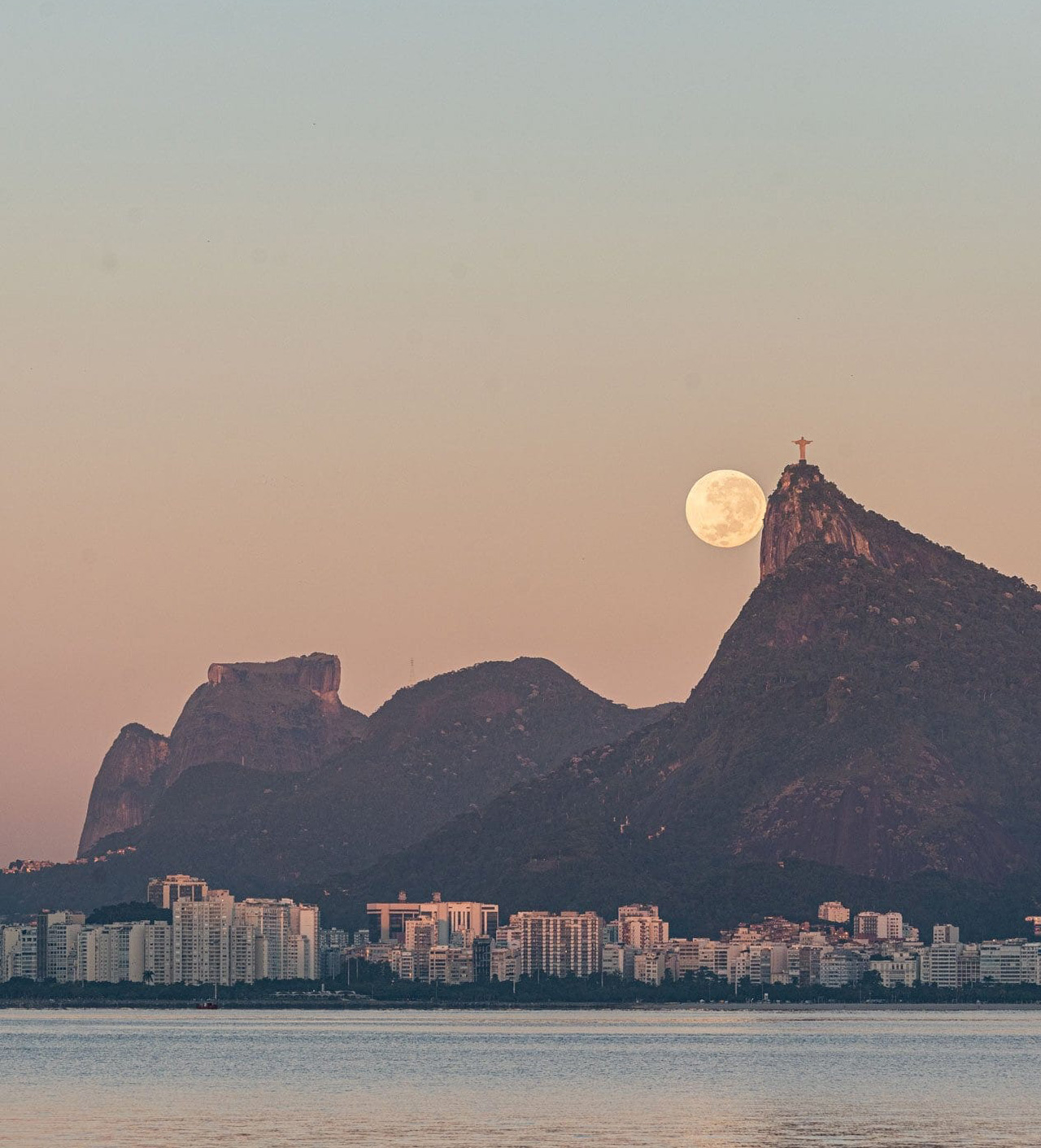
2) Solve the crossing
Use an ephemeris app: dial a date/time when the Moon’s azimuth/altitude kisses the hands from your pin; check phase for mood. Save the plan, then duplicate it for the next lunation, weather is a prankster.
3) Bring the right brush
A 300 - 600mm equivalent paints the scale relationship you’re after. Sens’s 600mm wasn’t overkill; it was prose style.
4) Arrive early; move like a crab
Lock tripod, watch the Moon’s drift, sidestep to finesse the hold. If the “hands” miss, pivot to a shoulder-halo or head-kiss composition.
5) Respect the odds
In Rio, clear skies hover near 40 - 50% on any given day. Build a two-night window; treat failure as rehearsal. Sens did.
Other Places Your Eye Will Enjoy
- Icaraí Beach, Niterói - the proven moon-shot baseline with forgiving horizons and big-city bokeh.
- Sugarloaf / Morro da Urca - classic harbor geometry; stage Christ as a skyline actor.
- Mirante Dona Marta – a painterly lower angle; when mist collaborates, Turner visits Rio.
Make it a series: call it “Gestures”, hands, shoulder, crown, across different nights. Curators love a thesis.
What the Numbers Say (About Us, not just the Photo)
The picture racked up ~700,000 Instagram likes and six-figure Reddit engagement. Beyond metrics, that’s a vote for images that re-author famous places without cynicism. The shot is repeatable in technique, and that’s good news. Craft isn’t a secret society; it’s an invitation.
Counterpoint with teeth: Some pros sighed, “Achievable.” Correct, and yet someone had to see it first, then wait three years. Vision + patience is still a competitive advantage.
Coda: On Patience and Public Art
Great monuments make cities legible; great photographs make time legible. On one blue-gold evening in Rio, Brazil, Christ the Redeemer didn’t watch over the bay; he learned a new gesture. The Moon, briefly, took direction.
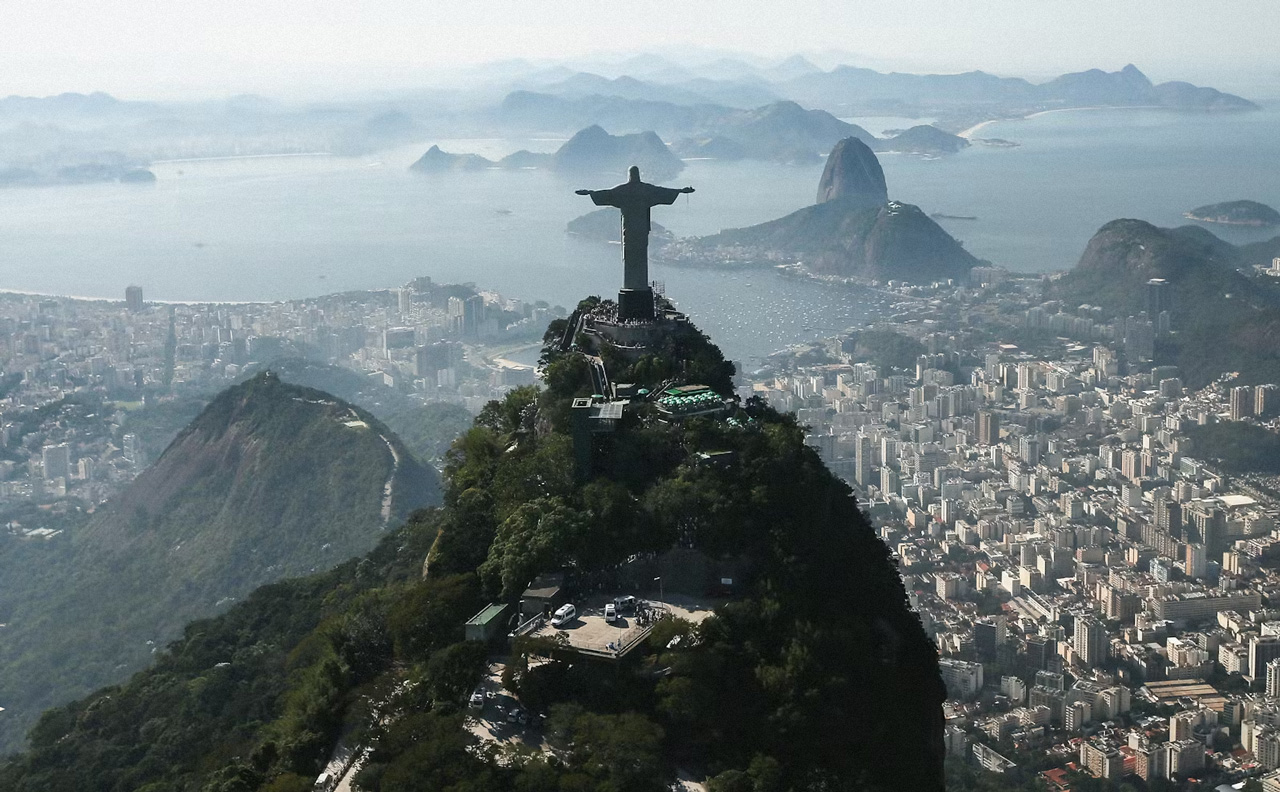
Quick Facts: Christ the Redeemer statue in Rio de Janeiro, Brazil
If you landed here searching for Christ the Redeemer statue in Rio de Janeiro, Brazil, here’s the fast, art-minded brief:
- Setting: Mount Corcovado above Rio, within Tijuca National Park; long-baseline views make the gesture read from across the bay.
- Why it photographs so well: Art-Deco massing, soapstone skin, and strong graphic silhouette designed to be legible at distance.
- Signature look: Distance “flattens” space so Moon + statue read as a single gesture, poetry via geometry.
- Best timing: Golden hours and crisp evenings; allow buffer for haze and lateral micro-adjustments.
Construction (in one paragraph)
A reinforced-concrete core supports a skin of soapstone tesserae chosen for weather resistance and gentle reflectance, an Art-Deco solution built for mountain winds and long-distance legibility. That structural clarity is why long-baseline alignments feel inevitable rather than gimmicky.
Pictures: what to look for
Christ the Redeemer Rio de Janeiro Brazil pictures, or photographs using professional cameras, as a tourist, this is what i crave the most on my planned holiday vacantion. Notice how each frame uses distance and angle: the skyline as counterpoint, the hands as gesture, and the Moon as co-star. Scan the captions above, each explains why the image works, not just what it shows.
Christ the Redeemer: FAQs (for People Also Ask)
Where is the Christ the Redeemer statue in Rio, Brazil?
On Mount Corcovado above Rio de Janeiro, inside Tijuca National Park. Long-baseline vantage points across the bay create the famous “Moon in the hands” effect.
What are quick facts about Christ the Redeemer in Rio de Janeiro, Brazil?
Art-Deco design; reinforced concrete core; soapstone cladding; sited for weather resistance and long-distance legibility over Guanabara Bay.
How was the Christ the Redeemer statue constructed?
A concrete-and-steel structure sheathed in soapstone tiles: durable, repairable, and softly reflective in Brazil’s strong light.
Any tips for that “Moon in the hands” photograph?
Choose a long baseline, plan the azimuth/altitude crossing in advance, arrive early, and be ready to sidestep as the Moon drops roughly one diameter every couple of minutes.
Planning note (for the quietly obsessed)
If you want to try the alignment yourself, open Photo Ephemeris (TPE Web), drop a pin on Icaraí Beach, and scrub the date/time slider until the Moon’s azimuth and altitude intersect Christ’s hands from your vantage. Save one primary plan and one backup; bring patience and a touch of stubbornness.

